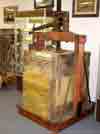| |

|
Edward E. King Museum
To understand the soul of
East Hartford, you need to examine the roots of its development. Two of
the strongest economic contributors have been tobacco farming and aviation.
---Ralph Secord understood this. As
head librarian (from 1949 to 1978) of the Raymond Memorial Library,
he supervised the building of a museum meant to preserve this dual heritage.
(This was also a requirement of the will of Albert C. Raymond,
the original benefactor of the library, who supplied a trust fund for
its completion.) Secord named it the Edward E. King Museum, after
a popular councilman of that time. It was opened in 1980, with Ralph Secord
as the curator.
---The museum is neatly divided into two
sections. One focuses on tobacco farming, for which Connecticut's Tobacco
Valley is famous. The other displays a portion of aviation history,
for which East Hartford's Pratt & Whitney was a prime contributor.
Most residents of the town have ancestral roots leading to at least one
of these industries.
---Upon visiting the museum, you have to
choose which section you want to enter first. Like choosing from two entirely
different worlds.
---On one side you are greeted by farming
tools from long ago, most prominently a tobacco wagon measuring more than
half the entire length of the room, sporting a wooden Indian at its head.
---All around are various farm implements
of wood and steel, with photos showing prosperous agrarian settings, and
the people who worked them. A bundle press is on display, open as if waiting
for its next bundle of tobacco. There are also cigar advertisements reminiscent
of the times, such as Briggs - when a feller needs a friend.
---Touching these artifacts, one naturally
considers those other hands, long ago, that worked with them in the fields
under the warm New England sun. Hard work. Back-breaking after a while.
Attracting hundreds of people from out-of-town, and from other countries
as well - people who then moved to East Hartford and made it home. It
is said that at one time you could hear 68 different languages within
the town limits.
---Opportunities brought by aviation accounted
for a significant part of this immigration. During World War II, some
40,000 workers built aviation war supplies to support the war effort.
---You can appreciate this in the next room.
In stark contrast to the rough, wooden displays of the previous area,
are shiny steel engines, one representing propeller flight, another jet.
The design cleverly includes a circular entranceway, making it clear that
you've stepped into another world, modern, a place honoring humanity's
achievement in flight.
---The history of aviation in East Hartford,
captured in pictures and diagrams all around, resembles an evolution chart
of aerodynamics. From those earliest flights, when the pilot was harnessed
in a delicate framework of sticks and canvas, to fighter plane development
and the helicopters that followed. There is even a section of photos chronicling
when propellers were made by Hamilton Standard.
---One fascinating display shows a real jet
engine from Pratt & Whitney, with sections removed so you can view
the inside. Its compressor shows a series of discs with angled blades
meant to force compressed air into the combustion chamber. Fuel is then
added, building further pressure to propel the engine forward.
---Nearby is an informative wall chart, illustrating
the basics of propulsion.
---These two very different exhibits reveal
some of the dimensions of East Hartford's past that are well worth the
visit - especially if you're a history buff, or interested in aviation.
---The museum is located on the second floor
of the East Hartford Library, at 840 Main Street.
---For details, Call: 860 289-6429.
See Photos.
Top
Photos from Edward K. King Museum(Click photos to
enlarge.)
 |
|
The museum is divided into two sections.
This is the entrance to the tobacco farming area. |
| |
|
|
 |
|
A lengthy tobacco wagon is on display.
Try to figure out how they got it into the room. |
| |
|
|
 |
|
Another angle of the tobacco wagon. |
| |
|
|
 |
|
A maching used to press tobacco. |
| |
|
|
 |
|
As you enter the aviation section
of the museum, you can see a jet engine on display. |
| |
|
|
 |
|
See the workings of a propeller engine. |
| |
|
|
 |
|
The museum has many historical photos on
display, along with posters, charts and engines. |
| |
|
|
Top
|
--- |

